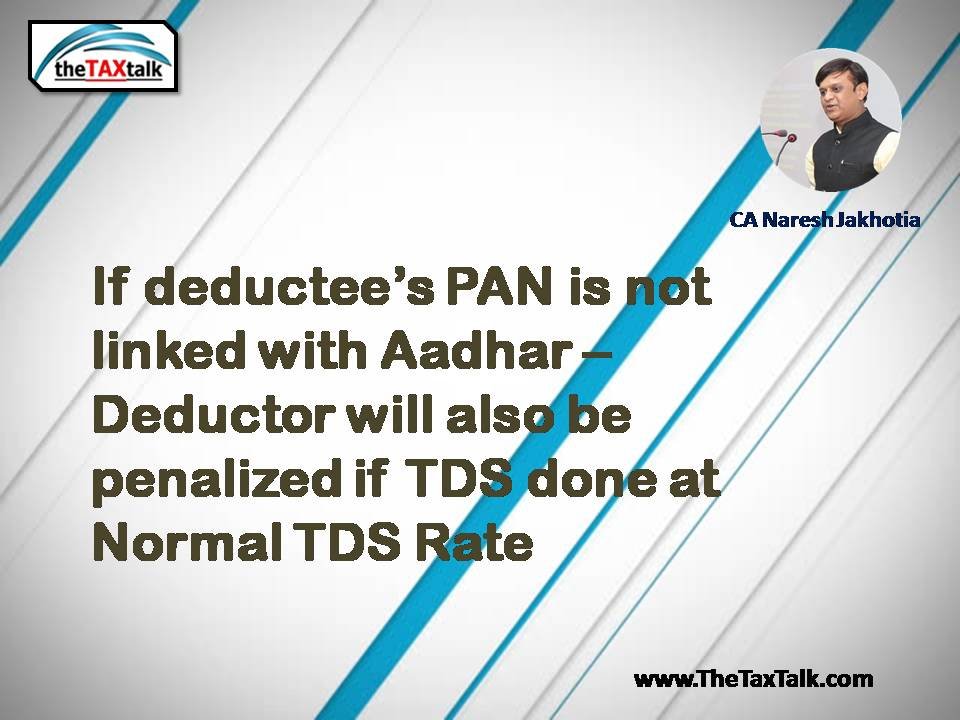![]()
If deductee’s PAN is not linked with Aadhar – Deductor will also be penalized if TDS done at Normal TDS Rate
Lot of taxpayers and businessmen are now receiving or will receive the short deduction notice by TDS CPC. Let us know the reason and the reason for issuance of such notices
1.Tax Deduction at Source (TDS) is required to be done by the taxpayers at prescribed rate. Normally, the TDS rate is in the range of 0.10% to 10% depending upon the nature of payment, for example, interest payment attracts TDS @ 10%, commission @5%, Purchase of goods exceeding Rs. 50 Lakh @0.10% and TDS on purchase of property exceeding Rs. 50 Lakh attracts TDS @1%.
2.The normal rate of TDS as discussed hereinabove is subject to a rider that the recipient has a valid PAN and the same is furnished to the payer.
3.In case the recipient (i.e., deductee) doesn’t have a valid PAN or didn’t furnish it to the deductor then the TDS is applicable at a higher rate which is normally 20% (5% in case payment is covered by section 194-O/194-Q). Further, a person who doesn’t have a valid PAN cannot furnish declaration in Form 15G/15H.
4.Income tax Act categorically provides that, if the PAN provided to the deductor is invalid or does not belong to the deductee then it shall be deemed that the deductee has not furnished his PAN & TDS shall be required to be done at a higher rate of 20% or 5%.
5.Taxpayers may recall that the income tax law provided for compulsory linking of PAN with Aadhar and the last date for linking was 30th June 2023. Those PAN which has not been linked with Aadhar has now become inoperative. Around 11.50 Cr of the existing PAN has been invalidated as of now.
6.As a result of this, payment to all the persons whose PAN is not linked with Aadhar will attract TDS at a higher rate of 20% or 5% and not at a regular rate of TDS.
7.Taxpayers may note that the liability to do TDS triggers in the hands of the deductor (a) at the time of payment or (b) at the time of credit to the account of the payee, whichever is earlier. If on the date of making the payment/credit, the PAN of the deductee is invalid then the TDS will be required to be done at a higher rate of 20% or 5%. In short, the deductor has to do TDS at the rate as applicable at the time of payment/credit. The change in the status of the PAN from invalid to valid at subsequent dates will not change the liability which has already triggered at the time of payment/credit only.
For example, M/s. X Ltd has paid interest of Rs. 1 Lakh to Mr. A on 01.11.2023. The PAN of Mr. A was invalid on 01.11.2023 as it was not linked with Aadhar. Subsequently, Mr. A linked the PAN with Aadhar on 02.11.2023. In this case, since the liability of M/s. X Ltd has arisen on 01.11.2023, TDS is applicable at a higher rate of 20%. Even though the status of the PAN has changed from invalid to valid on the very next day, the deductor is not allowed to proceed with TDS at a lower rate.
Representation to CBDT:
TDS is already an unrewarding compliance burden on the deductor just to ensure that the Income tax department is able to track the taxability of income in the hands of the recipient. The issue is going to be full of litigation and complications. It would be better if CBDT comes out with some relief and relaxation to make the provision friendly from the perspective of the deductor. There are few expectations of the taxpayers from CBDT:
1.Present amendment is designed to ensure that every PAN gets linked with Aadhar. When the same is achieved then the correction statement should rectify the demand retrospectively. Asking the taxpayers to pay TDS at a higher rate despite the fact that TDS is done by the payer at a lower rate & income trail is already established is unnecessary complicating the issue.
2.CBDT needs to distinguish the case of invalid PAN from No PAN cases. In my view, CBDT should give blanket relief to the taxpayers in such cases. At least, some relaxation should be provided for FY 2023-24 as this is the first year wherein taxpayers may be realizing its impact.
3.Further, the present utility “e-verify PAN” at the income tax portal provides the status of the PAN as on the date of search and there is no utility or feature to provide the status of the PAN of earlier date.
For example, M/s. X Ltd has purchased the goods of Rs. 1 Cr from Mr. A on 01.11.2023. The PAN of Mr. A was invalid on 01.11.2023 as it was not linked with Aadhar.
Subsequently, Mr. A linked the PAN with Aadhar on 02.11.2023.
M/s. X Ltd has paid the amount against purchase to Mr. A on 03.11.2023.
At the time of payment, M/s X checked the status of the PAN at the income tax portal (prior to making the payment) and found on the date of the payment that the PAN is valid one and so deducted the TDS @ 0.10% i.e., at normal TDS Rate under section 194Q prior to making the payment and recorded it in its books. Now, M/s X Ltd is sure to get the short deduction notice.
In this case, M/s X Ltd will not be having any tool to verify the status of the PAN as on 01.11.2023 after the expiry of the said date. In short, verification at the time of “Payment or credit, whichever is earlier” is the only date where the deductor can carry out the verification activities. On 03.11.2023, M/s X Ltd will find the status of Mr. A as valid only.
In this case, since the liability of M/s. X Ltd has arisen on 01.11.2023 and since the PAN is invalid as on that date, TDS is applicable at a higher rate of 5%.
Even though the status of the PAN has changed from invalid to valid on the very next day, the deductor is not allowed to proceed with TDS at a normal TDS rate. It may have happened that M/s X Ltd has received the goods on 02.11.2023 but recorded it in its books on 01.11.2023 from GST perspective; still the benefit of normal TDS rate will not be available as the date of credit will be reflected as 01.11.2023 & not 02.11.2023.




